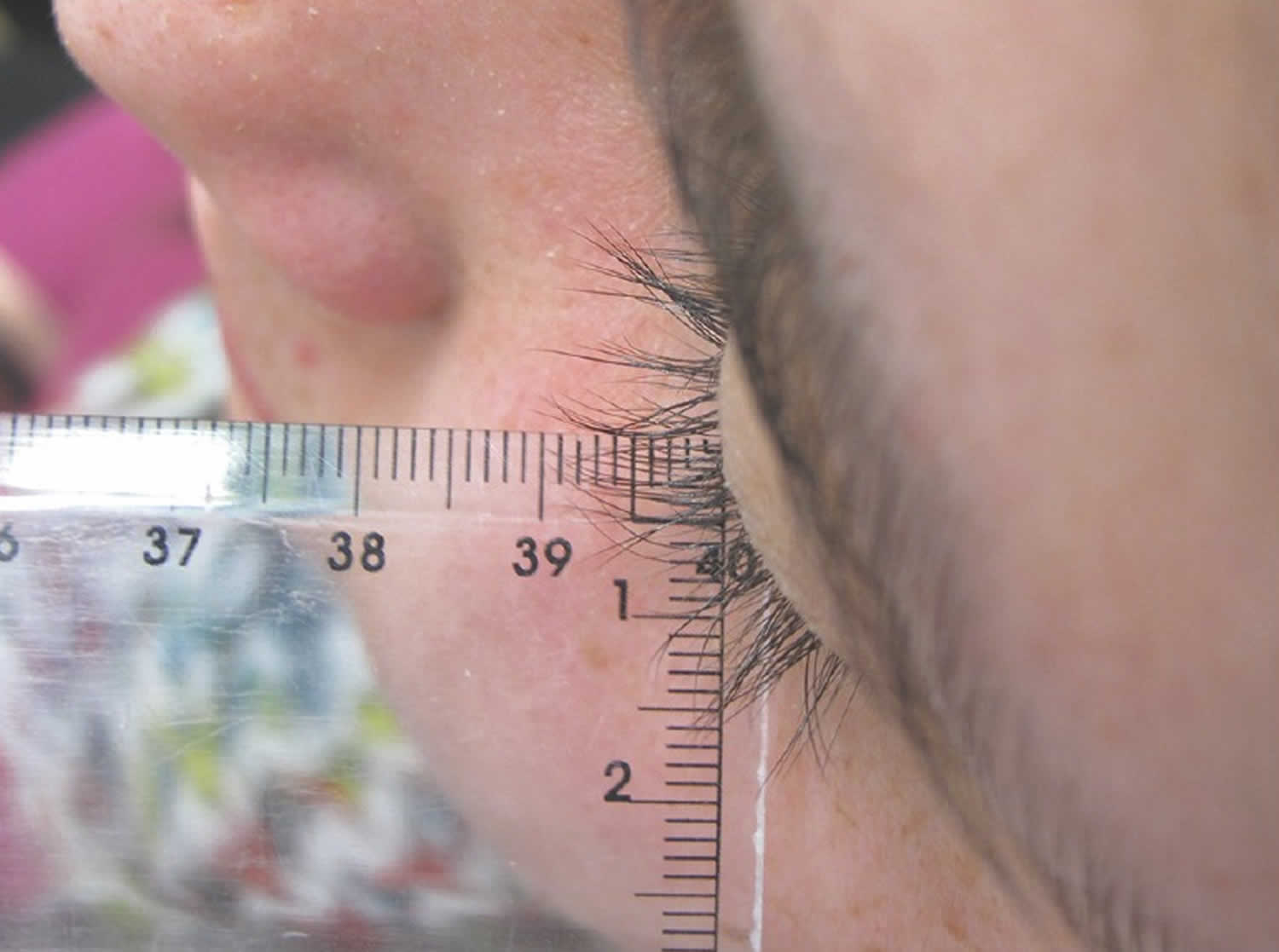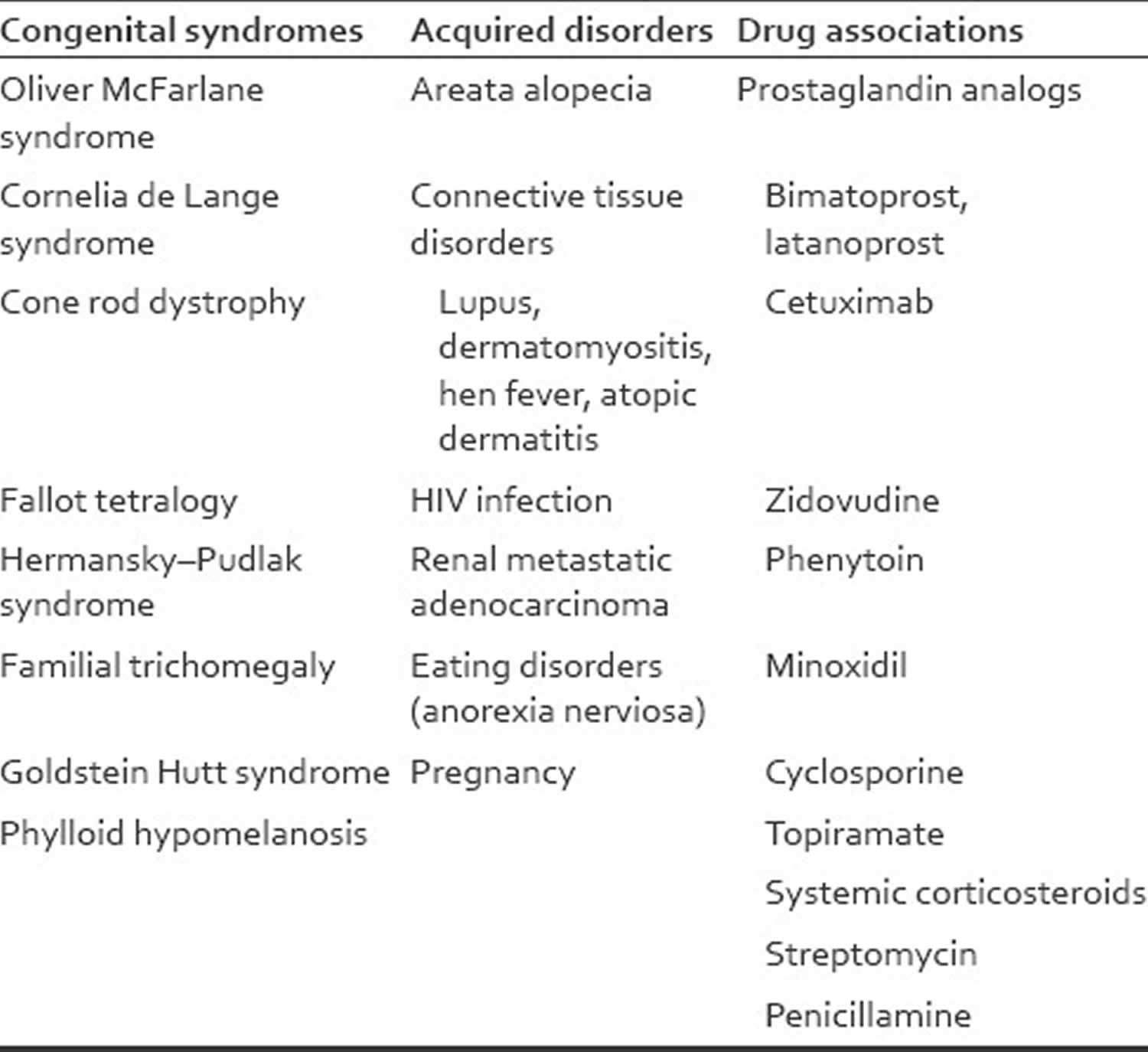Eyelash trichomegaly
Eyelash trichomegaly is increased length (12 mm or more), curling, pigmentation or thickening of eyelashes 1. The term “trichomegaly” was first used by Gray in 1944 2. Various causes of trichomegaly include congenital syndromes, acquired conditions and drugs. It can manifest at birth or present later in life. Eyelash trichomegaly can form a part of spectrum of manifestations of some congenital syndromes. Although eyelash trichomegaly tends to have a benign course, it can lead to psychological disturbances and can result in corneal abrasions and visual disturbances, if trichiasis occurs 3.
During embryological development, eyelashes are the first terminal hairs to appear 2. Eyelash hair has a growth cycle that lasts approximately 5-6 months, with a very short anagen phase (30 days) and a relatively long telogen phase (approximately 4-5 months) 1. Eyelashes and eyebrows have the lowest ratio of anagen to telogen hair follicles, with approximately 50% of eyelashes in the anagen phase compared with scalp hair where the anagen phase lasts approximately 3 months and 70% of the hairs are included in this phase 4.
Trichomegaly treatment is symptomatic and sometimes requires the use of artificial tears to prevent associated meibomitis 5.
Figure 1. Eyelash trichomegaly
[Source 2 ]Eyelash trichomegaly causes
Causes of eyelash trichomegaly include congenital, pharmacological and acquired disorders and are summarized in Table 1. The epidermal growth factor receptor appears to play a crucial role in hair growth as evidenced by drugs that inhibit its function. In addition, prostaglandins have been shown to be able to convert the hair follicle from the telogen phase into the anagen phase 6. In the pathophysiology of eyelash trichomegaly, some immune factors such as prostaglandins and epidermal growth factor appear to be involved 2. Both mediators increase the duration of the anagen period on the hairs in this area.
Acquired eyelash trichomegaly has been reported with topical use of prostaglandin analogue, latanoprost. The effects of prostaglandin F2-alpha and latanoprost have been found to stimulate not only murine hair follicles and follicular melanocytes but also the conversion from telogen to anagen phase. This side effect has also been tried for cosmetic effects. The Food and Drug Administration (FDA) approved bimatoprost 0.03% solution for treatment of patients with hypotrichosis of the eyelashes in December 2009 7.
Epidermal growth factor receptor (EGFR) inhibitors are used to treat a variety of solid tumors like bladder, breast, colorectal, head and neck, lung, and ovarian cancers. There are two classes of drugs that target the epidermal growth factor receptor: monoclonal antibodies that block the receptor itself (cetuximab, panitumumab) and small molecules that inhibit the tyrosine kinase activity, thereby blocking receptor activation (gefitinib, erlotinib). Trichomegaly induced by EGFR inhibitors, a result of enhanced terminal differentiation, usually occurs after 2-5 months of treatment, and can be associated with hypertrichosis in other areas. The cutaneous adverse effects of these agents have been grouped into a condition known as PRIDE (papulopustules and/or paronychia, regulatory abnormalities of hair growth, itching, and dryness due to epidermal growth factor receptor inhibitors) syndrome 8.
Table 1. Eyelash trichomegaly causes
Congenital conditions associated with eyelash trichomegaly
Among various congenital conditions associated with eyelash trichomegaly (Table 2), only two include it as a defining diagnostic feature: Oliver-McFarlane syndrome and Cornelia de Lange syndrome.
Table 2. Trichomegaly syndrome
Acquired conditions associated with eyelash trichomegaly
In HIV trichomegaly has been observed to occur in association with late-stage disease. Eyelash length has been shown to normalize as patients respond to anti-retroviral therapy 9. However, no association has been seen between the length of eyelashes and either the severity or prognosis of HIV infection. Acquired conditions associated with eyelash trichomegaly is mentioned in Table 3.
Table 3. Acquired conditions associated with eyelash trichomegaly
Drugs associated with eyelash trichomegaly
- Prostaglandin analogues like latanoprost and bimatoprost: Most commonly reported cause of eyelash trichomegaly.
- Epidermal growth factor receptor inhibitors: cetuximab 10, Panitumumab; tyrosine kinase inhibitors: erlotinib 11 or gefitinib 12
- Interferon-α2b 13. The first report of interferon-associated eyelash trichomegaly was in two patients with B-cell lymphoma treated with interferon 14. After 4 months of treatment, both patients began to note that their eyelashes had thickened, curled, and reached lengths of 20–65 mm.
- Zidovudine
- Phenytoin
- Diazoxide, minoxidil
- Acetazolamide
- Cyclosporine, tacrolimus
- Topiramate
- Psoralens
- Corticosteroids
- Streptomycin
- Penicillamine
Eyelash trichomegaly diagnosis
Eyelash trichomegaly diagnosis should include an overall evaluation of the patient’s history and other concurrent medical problems.
The onset of eyelash trichomegaly is an important point for delineating a specific etiology. If present from birth, one should look for other hair anomalies or facial features that may be present (such as alopecia, synophrys) and may suggest one of the congenital syndromes described earlier.
If onset is in later life, one should focus on medications or topical products and a risk assessment for HIV or hepatitis virus should be made.
Eyelash trichomegaly treatment
The main treatment of eyelash hypertrichosis involves regular trimming of the eyelashes if they cause symptoms 15. Sometimes antibiotics and artificial tears may be necessary for local irritation or meibomitis 16.
References- Santmyire-Rosenberger BR, Albert M. Acquired trichomegaly with topiramate. J Am Acad Dermatol. 2005;53:362–3.
- Kaur S, Mahajan BB. Eyelash Trichomegaly. Indian J Dermatol. 2015;60(4):378-380. doi:10.4103/0019-5154.160484 https://www.ncbi.nlm.nih.gov/pmc/articles/PMC4533537
- Manjunatha NP, Gnanaraj L. Isolated trichomegaly causing mechanical ptosis. J Pediatr Ophthalmol Strabismus. 2008;45:384.
- Jayamanne DG, Dayan MR, Porter R. Cyclosporin-induced trichomegaly of accessory lashes as a cause of ocular irritation. Nephrol Dial Transplant. 1996;11:1159–61.
- oo TL, Francis IC. Intermittent blurred vision and trichomegaly due to latanoprost. Clin Experiment Ophthalmol. 2001;29:272–3.
- Sasaki S, Hozumi Y, Kondo S. Influence of prostaglandin F2alpha and its analogues on hair regrowth and follicular melanogenesis in a murine model. Exp Dermatol. 2005;14:323–8.
- Mechcatie E. Bimatoprost approved for eyelash lengthening. Skin Allergy News. 2009;40:10.
- Lacouture ME, Lai SE. The PRIDE (Papulopustules and/or paronychia, Regulatory abnormalities of hair growth, Itching, and Dryness due to Epidermal growth factor receptor inhibitors) syndrome. Br J Dermatol. 2006;155:852–4.
- Almagro M, del Pozo J, García-Silva J, Martínez W, Castro A, Fonseca E. Eyelash length in HIV-infected patients. AIDS. 2003;17:1695–6.
- Bouché O, Brixi-Benmansour H, Bertin A, Perceau G, Lagarde S. Trichomegaly of the eyelashes following treatment with cetuximab. Ann Oncol. 2005;16:1711–2.
- Papadopoulos R, Chasapi V, Bachariou A. Trichomegaly induced by erlotinib. Orbit. 2008;27:329–30.
- Pascual JC, Bañuls J, Belinchon I, Blanes M, Massuti B. Trichomegaly following treatment with gefitinib (ZD1839) Br J Dermatol. 2004;151:1111–2.
- Goksugur N, Karabay O. Eyelash and eyebrow trichomegaly induced by interferon-alfa 2a. Clin Exp Dermatol. 2007;32:583–4.
- Foon KA, Dougher G. Increased growth of eyelashes in a patient given leukocyte a interferon. N Engl J Med. 1984;311:1259.
- Dueland S, Sauer T, Lund-Johansen F, Ostenstad B, Tveit KM. Epidermal growth factor receptor inhibition induces trichomegaly. Acta Oncol. 2003;42:345–6.
- Zhang G, Basti S, Jampol LM. Acquired trichomegaly and symptomatic external ocular changes in patients receiving epidermal growth factor receptor inhibitors: Case reports and a review of literature. Cornea. 2007;26:858–60.









